In most gardens and houses, African violets are grown due to their ability to bloom all year. Blooming doesn’t happen right after planting. It takes some months to bloom.
So a common question that comes to everyone’s mind is when do African violets bloom? Let’s find out.
In general, African violets bloom year-round if they are provided with the proper care and living conditions. Once bloomed, each flower lasts for 2-3 weeks before they start withering. A young African violet often takes 8-10 months to mature before it starts producing flowers.
African violets will not bloom if they do not reach their maturity stage. Moreover, if not provided with the right growing conditions and basic needs, your plant won’t have blooms.
If you wish to grow African violets in your garden or as houseplants, this article will help you understand their ideal blooming time and how often they will bloom. We will also cover information regarding the conditions the African violets will need to bloom.
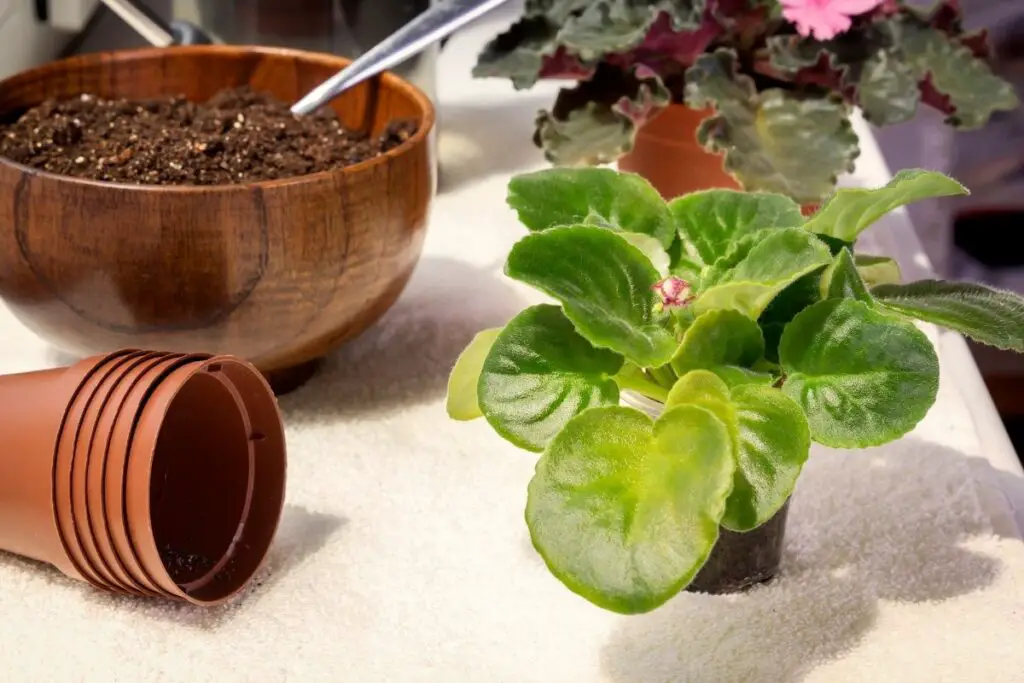
When do African violets bloom?
Luckily, these beautiful plants will bloom and fill your garden or house with flowers all year round. As long as you give all the requirements adequately at the right time, they will bloom continuously. The healthy flowers will last up to two to three weeks.
There is no specific time or season for African violets blooms. This is the reason you can find these plants in more or less all gardens and houses. But African violets will not bloom until the plant reaches its maturity.
If you have planted a young African violet, your plant will take 7 to 9 months to reach its maturity. Once they reach their maturity, you will start seeing blooms.
Most plants do not bloom during the winter months. But the African violets will bloom even in the dark, cold winters. You will find colorful African violet blooms that make your place visually attractive with the right growing conditions.
How often do African violets bloom?
Given the right growing conditions, such as ample indirect sunlight, the correct soil, fertilizer, and proper watering, African violets will bloom regularly for 10 to 12 months in a year.
Most African violets should contain one crown. The plant encourages producing flowers from new growth, especially the first three to four rows of leaves. If your African violet has more rows, it will flower poorly or won’t flower at all.
As I said earlier, they won’t bloom until maturity. But if you have bought plants that already have flowers, you are lucky that you do not have to wait for 6 to 9 months to see blooms in them.
However, after bringing the African violets home, you will not find any more blooms in them again if you do not give them their proper growing conditions and requirements.
You do not have to worry if you grow many varieties together and find out that some plants have started blooming while others have not.
Some varieties will flower when the right time comes. Just be patient, wait and continue performing proper cultural and environmental practices.
Another factor responsible for blooms in African violet is their gene. If they own good genes, then sooner or later, they are bound to bloom every two to six months.
How to get abundant blooms in your African violets?
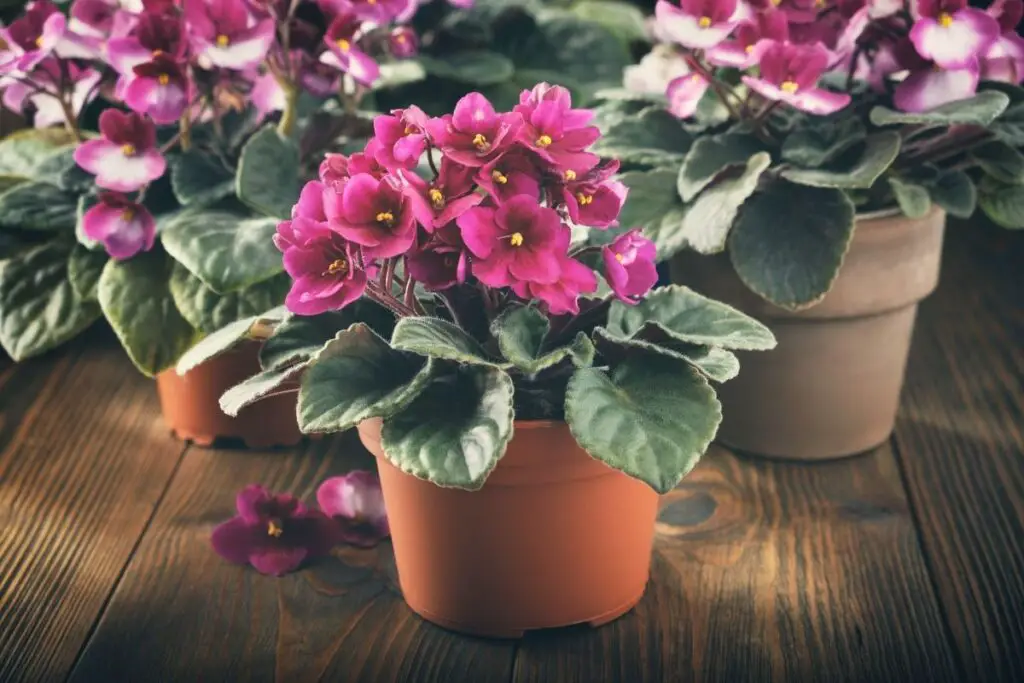
Before knowing how to get blooms, you have to be clear about why your African violets sometimes stop blooming.
After some blooms, you suddenly do not find any blooms in your plant. This happens when we become negligent about our plants.
We need to provide the proper requirements constantly. As these plants are very picky, the absence of any basic needs will reduce or stop the blooming.
Let us see how we can get abundant blooms in them.
Light
One factor that encourages abundant blooms in African violet is light. But African violets cannot tolerate direct sunlight.
They need at least 12 hours of bright indirect sunlight for blooming. They will also need 8 hours of darkness which helps them trigger blooming.
To give your African violets a good amount of bright indirect sunlight, you will need to choose a perfect spot for them in your garden or house.
I would recommend that the north or east direction as these receive the perfect sunlight with less intensity.
If your house or garden receives less sunlight, you can arrange some grow lights. Keep 12 inches distance between the plants and the light.
Keep it on for 12 hours or more if the African violets are not receiving sunlight at all. Keep the lights off for the rest of the time.
If your garden is in the south or west, you will have to create artificial shelters to protect them from the direct sun. This shelter will give them indirect light. Grow light fixation in shelters will also be accessible.
Also read: What Kind Of Light Does An African Violet Need? (African Violet Light Requirements)
Fertilizers to encourage blooms
Continuous blooms will take a lot of nutrients. Experts suggest fertilizing the plant with every watering. This triggers the growth hormone in the plants for which they produce flowers.
When growing African violets, usually a balanced fertilizer with NPK 20:20:20 will work great. But for abundant blooms, you will need a fertilizer that contains high phosphorous content.
Phosphorous encourages prolific blooms. You will need a fertilizer with NPK 12:36:14 for blooming. Frequent usage of dilute fertilizer will encourage blooming.
Also read: What Kind Of Fertilizer Is Good For African Violets? (+Best Picks)
Looking for gardening supplies? We have tested 100's of products before recommending them to you guys. Check out our best pick below:
| Image | Gardening Supplies | Best Price? |
|---|---|---|
 Top
Top Top
Top | Raised Garden Bed Kit | Check On Amazon |
 | XLUX Soil Moisture Meter, Plant Water Monitor, Soil Hygrometer Sensor for Gardening, Farming, Indoor and Outdoor Plants, No Batteries Required | No Results |
 Top
Top Top
Top | 82 Pcs Garden Tools Set and Extra Succulent Tools Set | Check On Amazon |
 | Joeys Garden Expandable Garden Hose with 8 Function Hose Nozzle, Lightweight Anti-Kink Flexible Garden Hoses, Extra Strength Fabric with Double Latex Core, (50 FT, Black) | No Results |
 Top
Top Top
Top | Dual Chamber Compost Tumbler | Check On Amazon |
 Top
Top Top
Top | Sunnyglade Plant Stakes | Check On Amazon |
 Top
Top Top
Top | Organic Cold Pressed Neem Seed Oil | Check On Amazon |
 Top
Top Top
Top | Mighty Mint Gallon :-Insect and Pest Control Peppermint Oil | Check On Amazon |
 Top
Top Top
Top | Scotts DiseaseEx Lawn Fungicide | Check On Amazon |
 Top
Top Top
Top | Jacks Classic 20-20-20 All Purpose Fertilizer | Check On Amazon |
 Top
Top Top
Top | 30,000 Seeds Pollinator Attracting Wildflower Mixture | Check On Amazon |
 Top
Top Top
Top | Survival Vegetable Seeds Garden Kit-Over 16,000 Seeds | Check On Amazon |
Soil
African violets will need porous and moist soil that can drain excess water and at the same time retain enough moisture.
A mixture of perlite, vermiculite, and peat moss will make an ideal soil mix for the African violets. The soil should support aeration so that the roots can breathe and receive oxygen.
Here is the exact soil mix for you:
- 1 cups of peat moss
- 1 cup of vermiculite
- 1 cup of perlite
- 1 cup worm casting/vermicompost
Along with that, the pH level of the soil is also necessary for blooms. African violets prefer pH ranging between 5.8 and 6.2. Poor soil quality won’t encourage any blooms.
Also read: What Kind Of Soil Is Best For African Violets? (+Best Soil Mix)
Water
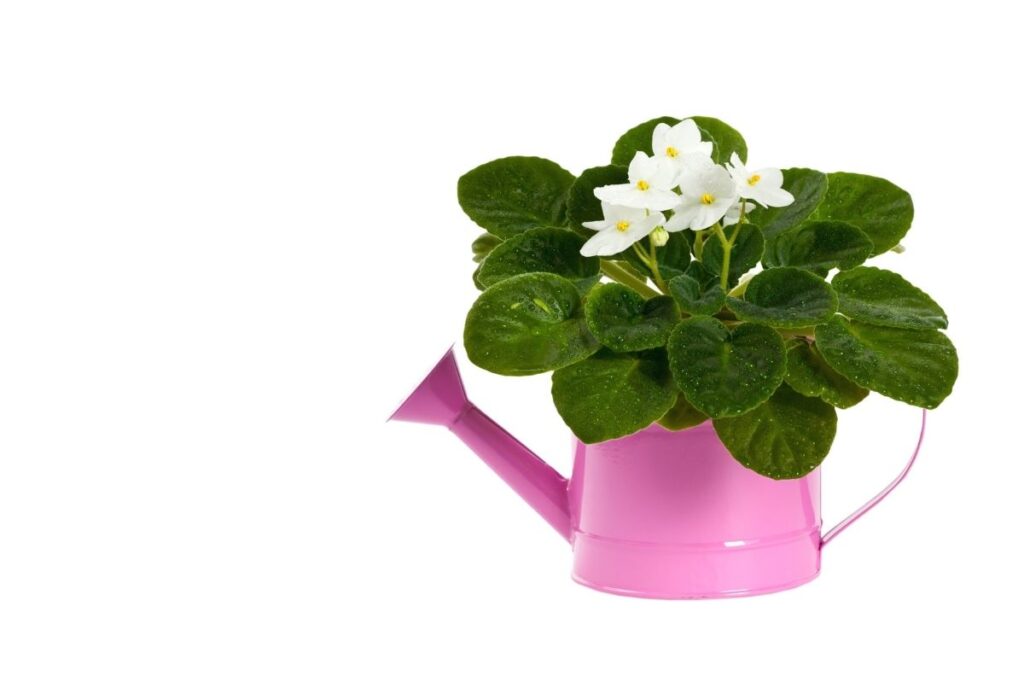
There is no specific rule for watering the African violets. They do not like staying in damp soil, neither do they like being in drought.
You need to check the moisture level of the soil constantly if you want blooms in your plant. Once the ½ inch of the soil dries up, water your African violets.
You should always use room temperature water for African violets. Use rainwater or filtered water instead of tap water.
Also read: How Often Should African Violets Be Watered? (African Violet Water Requirements)
Humidity
If your region has at least 40-50% humidity, you can prefer growing African violets in the garden.
During the winters, it can get difficult. However, it can be managed by misting. But water might get trapped in the fuzzy leaves. So mist occasionally.
You can keep some bowls filled with water around the soil bed or use a pebble tray for indoor African violets. This will raise their humidity level, matching the humidity of their native land to some extent.
While planting, you can plant them close to each other. Not too close, of course. If planting is already done, you can keep some potted plants around them. African violets prefer growing in crowds. Grouping will increase humidity up to 15%.
Adding mulch to the soil bed will also help in maintaining humidity.
Also read: Do African Violets Like Misting? (+Humidity Guide)
Temperature
African violets need temperatures ranging between 65-75°F. The outside temperature is not in our hands.
But still, you can manage it by proper light and watering. The shelter made for protecting them from the light will also protect them from cold.
If the soil temperature decreases, adding straw mulch will help to keep the soil warm and trap heat for the African violets.
Inside the house, you can control the temperature and provide the ideal temperatures for your African violets.
Also read: Can African Violets Grow Outside? (+Outdoor Care)
Extra crowded top growth
African violets have the habit of growing too many crowns. Due to this, the plant starts focussing on crown growth more than blooming. Dividing those crowns will help the plant focus its energy on producing flowers.
Remove dead blooms
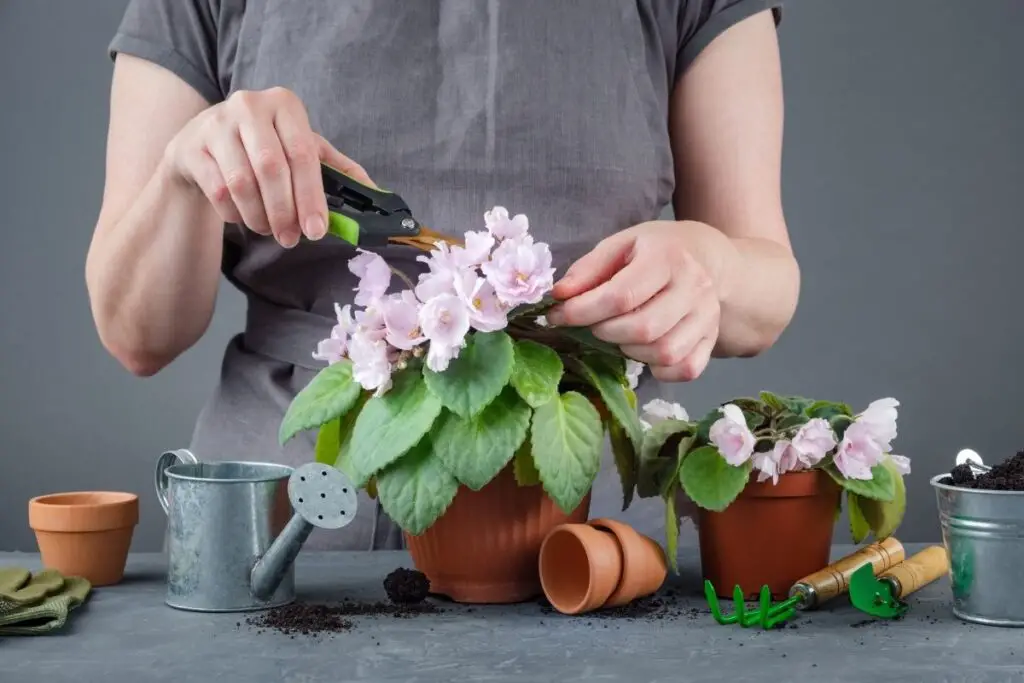
To promote continuous blooms, you will need to remove the spent flowers. As they bloom all year, they will have regular petals. But you won’t find any more bloom unless you remove the old ones.
The plant will constantly use its energy in the old ones. By removing them, the plant will again concentrate on growing more blooms.
Good air circulation impacts blooming.
While giving your African violets the correct humidity, we forget about air circulation. African violets prefer to be crowded.
But too much crowding will suffocate the plants and their roots. Along with that, we unknowingly create a medium for pathogens.
The plants must receive good airflow. This will also help them produce more blooms more often.
Some notable blooming techniques
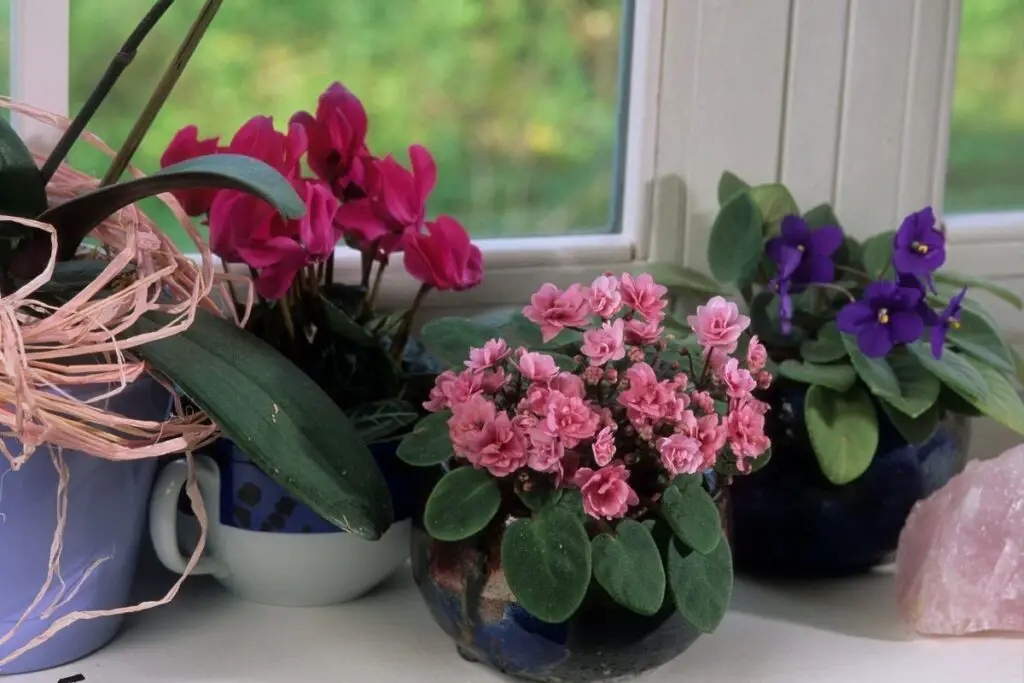
There are some special techniques to get blooms in your African violets:
Leaf cleaning
Water the African violets from the bottom, close to the soil. Try avoiding the leaves. Their fuzzy leaves tend to trap water.
But, you can rinse to clean the leaves regularly with room temperature water. After that, wipe the leaves and let them dry. Remove the shelter for some time so that the leaves can dry up in the sun.
You can do this every 6 to 12 months. This will keep the leaves clean, avoid pests, and encourage blooms.
Soil drenching
This helps in flushing off the salt accumulated due to over-fertilization. Do this when the soil is dry.
This will flush out all the leftover salts and fertilizers from the soil. After flushing, allow the soil to dry up and then resume regular watering. Avoid fertilizing for one week.
Performing this trick every three months will keep the soil clean. Good quality soil will encourage prolific blooms.
Leaf support
Sometimes, the lower leaves deform when they are constantly touching the surface of the soil bed.
You can give them some support with commercial support rings or plastic pie plates. This will keep them from distortion, and they will also receive sunlight.
Cutting out middleman
If you want to see flowers in your African violets, you need to keep them trimmed and focussed on blooming.
This will save energy, and the plant will concentrate more on blooms. 3 to 4 rows of leaves are enough.
Disbudding
This will help in increasing blooms in the future.
Removing the unhealthy buds and stems will turn the plant’s focus to grow new leaves, new flower buds, and healthy roots. It will boost the hormones beneficial for all year flowering.
Some reliable African violet bloomers
African violets having single flower and plain leaves are often the most reliable bloomers.
Hybrids are grown more due to their characteristics rather than flowers.
Some reliable African violet bloomers are:
- Colonial Broome
- Fun Trail
- Harbour Blue
- Christening Gown
- The Alps
- Ness’ Foggy Blues
- Phantom Flash
Final words
There is no such specific time as to when and how often African violets will bloom. The reason is these plants produce flowers throughout the year, even in the cold seasons of winters.
With proper care and attention, they will constantly bloom as long as they receive all the basic requirements on time.
If you have recently planted young African violets, you will have to wait until they become mature for blooming. Once they become mature, you will start seeing blooms.
Some varieties of African violets are slow bloomers, and some are fast. It depends on the variety of the plant. Do not be impatient. Keep taking care of them, and they will bloom when the time comes.
Source: Wikipedia, African violet: Classical breeding, African Violet Society of America, In vitro propagation of African violet, University of Florida, North Dakota State University, The University of Georgia.
